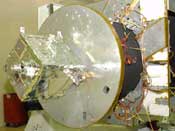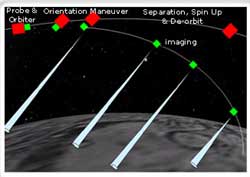Chandrayaan-1's MIP: Coming in over Malarpet Mountain
14 Nov 2008
Bangalore: The landing of the Moon Impact Probe (MIP) on the lunar surface Friday night will make India the fourth country in the world to impact the lunar surface with a probe. Neither of its two Asian counterparts, the Japanese Kaguya or the Chinese Chang-e carries such a payload.
The 35 kg probe, which carries the saffron, white and green colours of the Indian flag painted on its side, is slated to impact the lunar surface approximately 25 minutes after it is ejected out of the parent Chandrayaan vehicle at approximately 8.03-8.04 pm. The parent vehicle is currently in orbit at an altitude of 100 km above the moon.
 Former president and India's top rocket and defence scientist Dr APJ Abdul Kalam will be at ISRO's telemetry, tracking and command network (Istrac) on the outskirts of Bangalore to witness the historic moment.
Former president and India's top rocket and defence scientist Dr APJ Abdul Kalam will be at ISRO's telemetry, tracking and command network (Istrac) on the outskirts of Bangalore to witness the historic moment.
"Kalam will be at the spacecraft control centre of Istrac with Nair and other top scientists to observe the complex exercise when the probe will be separated from the mother spacecraft by activating a small thruster to descend through a sequence of commands from Istrac in coordination with the deep space network (DSN)," ISRO director S Satish said.
Speaking at the Aero Tech 2008 exhibition here in Chandigarh, Dr Kalam said, "The success of Chandrayaan-1 has given our space scientists and technocrats a reason to look forward to accomplish other space projects. This historic moon mission will provide us the vital clues about the origin and early history of the moon and the other planetary system."
The Moon Impact Probe The 35 kg mass MIP is attached at the top deck of the main orbiter and is to be released during the final 100 km x 100 km orbit today at 8.03 pm approximately. Indian Space Research Organisation (ISRO) chairman G Madhvan Nair said Thursday, "The probe will fly over the Malarpet mountain on the lunar surface and fall into a 19 km long crater near the moon's south pole and it's all going to be recorded on video for us to see," he said.
The 35 kg mass MIP is attached at the top deck of the main orbiter and is to be released during the final 100 km x 100 km orbit today at 8.03 pm approximately. Indian Space Research Organisation (ISRO) chairman G Madhvan Nair said Thursday, "The probe will fly over the Malarpet mountain on the lunar surface and fall into a 19 km long crater near the moon's south pole and it's all going to be recorded on video for us to see," he said.
'MIP will be detached 100 km above flying board at 8:03 or 8:04 pm and would take about 25 minutes to touch the lunar surface by free falling,' said ISRO spokesperson S Satish.
The 375 mm x 375 mm x 470 mm honeycomb structured has a Sanskrit shloka (verse) written on one of its sides.
Major Objectives:
- Design, development and demonstration of technologies required for impacting a probe at the desired location on the moon.
- Qualify technologies required for future soft landing missions.
- Scientific exploration of the moon from close range.
Payload Configuration Details:
There will be three instruments on the Moon Impact Probe
- Radar Altimeter â€'' for measurement of altitude of the Moon Impact Probe and for qualifying technologies for future landing missions. The operating frequency band is 4.3 GHz ± 100 MHz.
- Video Imaging System â€'' for acquiring images of the surface of the Moon during the descent at a close range. The video imaging system consists of analog CCD camera.
- Mass Spectrometer â€'' for measuring the constituents of tenuous lunar atmosphere during descent. This instrument will be based on a state-of-the-art, commercially available Quadrupole mass spectrometer with a mass resolution of 0.5 amu and sensitivities to partial pressure of the order of 10-14 torr.
MIP System Configuration
The MIP's honeycomb structure houses all the subsystems and instruments. In addition to the instruments, the separation system, the de-boost spin and de-spin motors, it comprises of the avionics system and thermal control system.
The avionics system supports the payloads and provides communication link between MIP and the main orbiter, from separation to impact and provides a database useful for future soft landing.
The mission will collect all the instrument data during descent and transmit to the main orbiter, which in turn will transmit them to the ground station during visible phases.




















